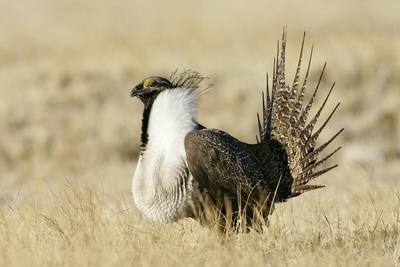
This post was written by Claudia Corona, 2010 Mono Lake Intern.
Have you ever seen a wild bird that looks like a cross between a chicken and a turkey? A churkey? A ticken? Well, I haven’t either … but I have seen Sage-Grouse! Sage-Grouse (Centrocercus urophasianus) is the largest grouse in North America, where it is known as the Greater Sage-Grouse. Sage-Grouse are, in fact, related to chickens and turkeys because they belong to the same taxonomic order of “Galliformes.” They range in length from 31 centimeters (12 inches) to 95 cm (37 in), and tend to weigh from 0.3 kilograms (11 ounces) to 6.5 kg (14 pounds).

Adults have a long, pointed tail and feathers from their bodies to their toes. Adult males have a yellow patch over the eye, are greyish on top with a white breast, a dark brown throat and a black belly. Adult females are mottled grey-brown with a light brown throat and dark belly.
Young Sage-Grouse eat insects, as well as non-woody plants; like dandelions and other small flowering plants because they need the energy to grow into adult grouse. If you thought that no creature ate sagebrush, think again! Once Sage-Grouse have reached their adult age, they feed on sagebrush, as they are an obligate species, meaning they, by nature, eat sage brush.
Joel Tebbenkamp, graduate student at the University of Idaho, was in charge of the Sage-Grouse research team based at the Mono Basin Field Station this summer. When I asked him to describe the bird species he was studying in one word, he answered; “Charismatic.” He said that they are charismatic because they are by no means mega-fauna, but there is something about their unusual behavior that makes people want to study them.
As a part of his graduate research, Joel and his team conducted a study of Sage-Grouse from March 1 to August 5. During this five-month study, they trekked through sagebrush and meadows around Crowley Lake, Parker Lake, the Bodie Hills, Fales Hot Springs, and Long Valley in order to study Greater Sage-Grouse.
First, the team tracks the Greater Sage-Grouse during the day. However, in order to track the Sage-Grouse they must first trap them; this takes place at night. Trapping Sage-Grouse isn’t permanent (or easy), but it is made possible with giant nets. Joel and his team took blood samples and genetic samples (such as a feather) for further study in the lab. They also attached radio collars to all of the Sage-Grouse that they trapped. These radio collars would help tell them if the birds were moving successfully from area to area.
In short, Joel’s project investigates the demographics of the Greater Sage-Grouse, such as survival of Sage-Grouse eggs and nest success. Nest success is defined as what nest sites chosen were the most successful for egg and chick survival. For example, there was one Sage-Grouse who chose a nest underneath dead sagebrush. At first, it was thought that this site would be unsuccessful at nesting because the sagebrush would no longer be helpful in feeding the Sage-Grouse and the site was too close to the ground, where it would be easily accessible to predators. But interestingly enough, it turned out to be a nest success, which Joel says will help unearth nesting patterns of Sage-Grouse.
When I asked Joel, “If you could speak to the Sage-Grouse for ONE minute, what would you say?” He said he would ask the Sage-Grouse that had chosen to nest under the dead sagebrush, “Why are you nesting here versus there?” Since sientific research doesn’t really work that way, so Joel will have to wait for the results of his study later this year when he goes back to school and analyzes the blood and genetic samples and the nesting success data. All in all, when I asked Joel to describe his time here at Mono Lake and the Eastern Sierra, he admitted that he couldn’t believe the summer had gone by so quickly. Summer is a great time of the year, it lasts long enough to warm our hearts, brighten our souls, and to unearth new information about the species that make the Eastern Sierra so amazing. And then it draws you back for more the next year.
